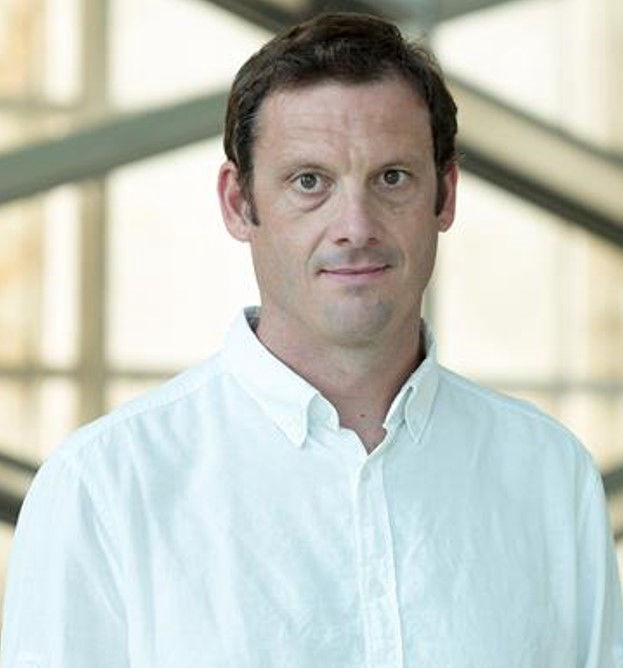Stefaan De Wolf
King Abdullah University of Science and Technology (KAUST), KAUST Solar Center (KSC), Physical Sciences and Engineering Division (PSE), Material Science and Engineering Program (MSE), Thuwal, 23955-6900, Saudi Arabia
Keywords: solar cells, photovoltaics, perovskites, silicon, clean energy
AbstractIn the presentation, I will discuss the multiple ways how monolithic perovskite/silicon can be fabricated, built from textured silicon heterojunction solar cells, with an emphasis on solution processing of the perovskite top cell. Bulk and contact passivation of the perovskite are instrumental to obtain a high performance, which can be obtained through molecular additive engineering and the use of a range of contact passivation layers [1,2]. Examples of effective passivation strategies are the use of molecular films at the hole-collecting metal-oxide / perovskite interface [3] and the use of fluoride-based layers at the electron-collecting perovskite / C60 interface [4]. This will be followed by a discussion about the outdoor performance of such tandems [5], the need for robust and perovskite-compatible encapsulation to do so, and the first longer-term outdoor measurements [6]. I will then move on to discuss reliability aspects of such tandems under accelerated degradation tests such as damp-heat testing, including device-engineering strategies to pass such tests [7]. I will also discuss other failure mechanisms to be overcome for perovskite/silicon tandems such as mechanical failure due to top-contact delamination [8] and potential induced degradation [9]. I will conclude my talk with arguing how bifacial perovskite/silicon tandems aid in improved performance as well as stability, thanks to their reliance on narrow-bandgap perovskites for optimal performance [10,11].
References
[1] F.H. Isikgor, F. Furlan, J. Liu, E. Ugur, M.K. Eswaran, A.S. Subbiah, E. Yengel, M. De Bastiani, G.T. Harrison, S. Zhumagali, C.T. Howells, E. Aydin, M. Wang, N. Gasparini, T.G. Allen, A. Rehman, E. Van Kerschaver, D. Baran, I. McCulloch, T.D. Anthopoulos, U. Schwingenschlogl, F. Laquai, and S. De Wolf, Joule 5, 1566 (2021).
[2] J. Liu, E. Aydin, J. Yin, M. De Bastiani, F.H. Isikgor, A.u. Rehman, E. Yengel, E. Ugur, G.T. Harrison, Y. Gao, M. Wang, j.I. Khan, M. Babics, T.G. Allen, A.S. Subbiah, K. Zhu, X. Zheng, W. Yan, F. Xu, M.F. Salvador, O.M. Bakr, M. Lanza, T.D. Anthopoulos, O.F. Mohammed, F. Laquai, S. De Wolf, Joule 5, 3169 (2021).
[3] F.H. Isikgor, S. Zhumagali, L.V.T. Merino, M. De Bastiani, I. McCulloch, and S. De Wolf, Nature Rev. Mater. (2022). https://doi.org/10.1038/s41578-022-00503-3
[4] J. Liu, M. De Bastiani, E. Aydin, G.T. Harrison, Y. Gao, R.R. Pradhan, M.K. Eswaran, M. Mandal, W. Yan, A. Seitkhan, M. Babics, A.S. Subbiah, E. Ugur, F. Xu, L. Xu, M. Wang, A.u. Rehman, A. Razzaq, J. Kang, R. Azmi, A.A. Said, F.H. Isikgor, T.G. Allen, D. Andrienko, U. Schwingenschlogl, F. Laquai, and S. De Wolf, Science 377, 302 (2022).
[5] E. Aydin, T.G. Allen, M. De Bastiani, L. Xu, J. Avila, M. Salvador, E. Van Kerschaver, and S. De Wolf, Nature Energy 5, 851 (2020).
[6] M. De Bastiani, E. Van Kerschaver, A. Rehman, E. Aydin, F.H. Isikgor, A.J. Mirabelli, S. Zhumagali, E. Ugur, G.T. Harrison, T.G. Allen, B. Chen, Y. Hou, S. Shikin, Q. Jeangros, C. Ballif, E.H. Sargent, M.F. Salvador, and S. De Wolf, ACS Energy Lett. 6, 2944 (2021).
[7] R. Azmi, E. Ugur, A. Seithkan, F. Aljamaan, A.S. Subbiah, G.T. Harrison, J. Liu, M.I. Nugraha, M.K. Eswaran, M. Babics, Y. Chen, F. Xu, T.G. Allen, A.u. Rehman, C.-L. Wang, T.D. Anthopoulos, U. Schwingenschlogl, M. De Bastiani, E. Aydin, and S. De Wolf, Science 376, 73 (2022).
[8] M. De Bastiani, G. Armaroli, R. Jalmood, L. Ferlauto, X. Li, R. Tao, G.T. Harrison, M. Babics, E. Aydin, T.G. Allen, C. Combe, T. Kramer, G. Lubineau, D. Cavalcoli, and S De Wolf, ACS Energy Lett. 7, 827 (2022).
[9] L. Xu, J. Liu, W. Luo, N. Wehbe, A. Seitkhan, M. Babics, J. Kang, M. De Bastiani, E. Aydin, T.G. Allen, M. Alamer, W. Yan, F. Xu, A.u. Rehman, and S. De Wolf, Cell Rep. Phys. Sci. 3, 101026 (2022).
[10] M. De Bastiani, A.J. Mirabelli, Y. Hou, F. Grota, E. Aydin, T.G. Allen, J. Troughton, A.S. Subbiah, F.H. Isikgor, J. Liu, L. Xu, B. Chen, E. Van Kerschaver, D. Baran, M.F. Salvador, U.W. Paetzold, E.H. Sargent, and S. De Wolf, Nature Energy 6, 167 (2021).
[11] M. De Bastiani, A.S. Subbiah, M. Babics, E. Ugur, T.G. Allen, E. Aydin, and S. De Wolf, Joule 6, 1431 (2022).

